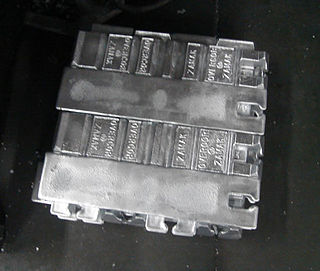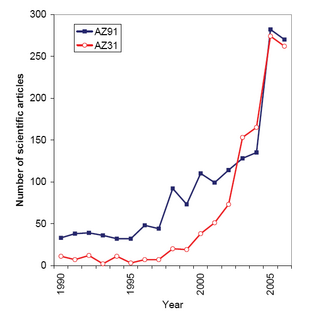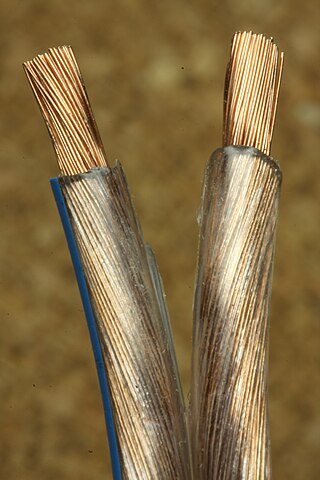Related Research Articles

Barium is a chemical element with the symbol Ba and atomic number 56. It is the fifth element in group 2 and is a soft, silvery alkaline earth metal. Because of its high chemical reactivity, barium is never found in nature as a free element.

Calcium is a chemical element with the symbol Ca and atomic number 20. As an alkaline earth metal, calcium is a reactive metal that forms a dark oxide-nitride layer when exposed to air. Its physical and chemical properties are most similar to its heavier homologues strontium and barium. It is the fifth most abundant element in Earth's crust, and the third most abundant metal, after iron and aluminium. The most common calcium compound on Earth is calcium carbonate, found in limestone and the fossilised remnants of early sea life; gypsum, anhydrite, fluorite, and apatite are also sources of calcium. The name derives from Latin calx "lime", which was obtained from heating limestone.

Magnesium is a chemical element with the symbol Mg and atomic number 12. It is a shiny gray metal having a low density, low melting point and high chemical reactivity. Like the other alkaline earth metals it occurs naturally only in combination with other elements and it almost always has an oxidation state of +2. It reacts readily with air to form a thin passivation coating of magnesium oxide that inhibits further corrosion of the metal. The free metal burns with a brilliant-white light. The metal is obtained mainly by electrolysis of magnesium salts obtained from brine. It is less dense than aluminium and is used primarily as a component in strong and lightweight alloys that contain aluminium.

Scandium is a chemical element with the symbol Sc and atomic number 21. It is a silvery-white metallic d-block element. Historically, it has been classified as a rare-earth element, together with yttrium and the lanthanides. It was discovered in 1879 by spectral analysis of the minerals euxenite and gadolinite from Scandinavia.

The alkaline earth metals are six chemical elements in group 2 of the periodic table. They are beryllium (Be), magnesium (Mg), calcium (Ca), strontium (Sr), barium (Ba), and radium (Ra). The elements have very similar properties: they are all shiny, silvery-white, somewhat reactive metals at standard temperature and pressure.
Aluminium–silicon alloys or Silumin is a general name for a group of lightweight, high-strength aluminium alloys based on an aluminum–silicon system, i.e., Aluminium-silicon alloys (AlSi) that consist predominantly of aluminum - with silicon as the quantitatively most important alloying element. Pure AlSi alloys cannot be hardened, the commonly used alloys AlSiCu and AlSiMg can be hardened. The hardening mechanism corresponds to that of AlCu and AlMgSi. The rarely used wrought alloys in the 4000 series and the predominantly used cast alloys are standardized in the 40000 series. AlSi alloys are by far the most important of all aluminum cast materials. They are suitable for all casting processes and have excellent casting properties. Important areas of application are in car parts, including engine blocks and pistons. In addition, their use as a functional material for high-energy heat storage in electric vehicles is currently being focused on.

Die casting is a metal casting process that is characterized by forcing molten metal under high pressure into a mold cavity. The mold cavity is created using two hardened tool steel dies which have been machined into shape and work similarly to an injection mold during the process. Most die castings are made from non-ferrous metals, specifically zinc, copper, aluminium, magnesium, lead, pewter, and tin-based alloys. Depending on the type of metal being cast, a hot- or cold-chamber machine is used.
Elektron is the registered trademark of a wide range of magnesium alloys manufactured by a British company Magnesium Elektron Limited.

ZAMAK is a family of alloys with a base metal of zinc and alloying elements of aluminium, magnesium, and copper.

Magnesium alloys are mixtures of magnesium with other metals, often aluminium, zinc, manganese, silicon, copper, rare earths and zirconium. Magnesium alloys have a hexagonal lattice structure, which affects the fundamental properties of these alloys. Plastic deformation of the hexagonal lattice is more complicated than in cubic latticed metals like aluminium, copper and steel; therefore, magnesium alloys are typically used as cast alloys, but research of wrought alloys has been more extensive since 2003. Cast magnesium alloys are used for many components of modern automobiles and have been used in some high-performance vehicles; die-cast magnesium is also used for camera bodies and components in lenses.
Magnalium is an aluminium alloy with 5% magnesium and 95% aluminum.

An aluminium alloy is an alloy in which aluminium (Al) is the predominant metal. The typical alloying elements are copper, magnesium, manganese, silicon, tin, nickel and zinc. There are two principal classifications, namely casting alloys and wrought alloys, both of which are further subdivided into the categories heat-treatable and non-heat-treatable. About 85% of aluminium is used for wrought products, for example rolled plate, foils and extrusions. Cast aluminium alloys yield cost-effective products due to the low melting point, although they generally have lower tensile strengths than wrought alloys. The most important cast aluminium alloy system is Al–Si, where the high levels of silicon (4–13%) contribute to give good casting characteristics. Aluminium alloys are widely used in engineering structures and components where light weight or corrosion resistance is required.
6061 is a precipitation-hardened aluminium alloy, containing magnesium and silicon as its major alloying elements. Originally called "Alloy 61S", it was developed in 1935. It has good mechanical properties, exhibits good weldability, and is very commonly extruded. It is one of the most common alloys of aluminium for general-purpose use.
2024 aluminium alloy is an aluminium alloy, with copper as the primary alloying element. It is used in applications requiring high strength to weight ratio, as well as good fatigue resistance. It is weldable only through friction welding, and has average machinability. Due to poor corrosion resistance, it is often clad with aluminium or Al-1Zn for protection, although this may reduce the fatigue strength. In older systems of terminology, 2XXX series alloys were known as duralumin, and this alloy was named 24ST.
5059 is an aluminium–magnesium alloy, primarily alloyed with magnesium. It is not strengthened by heat treatment, instead becoming stronger due to strain hardening, or cold mechanical working of the material.

Copper has been used in electrical wiring since the invention of the electromagnet and the telegraph in the 1820s. The invention of the telephone in 1876 created further demand for copper wire as an electrical conductor.
7178 aluminum alloy is wrought alloy. It has high zinc content. After annealing, aluminum alloy 7178 has high machinability. Resistance welding can be used.
Aluminium–copper alloys (AlCu) are aluminum alloys that consist largely of aluminum (Al) and traces of copper (Cu) as the main alloying elements. Important grades also contain additives of magnesium and silicon, often manganese is also included to increase strength. The main area of application is aircraft construction. The alloys have medium to high strength and can be age-hardened. They are both wrought alloy. Also available as cast alloy. Their susceptibility to corrosion and their poor weldability are disadvantageous.
Aluminium–scandium alloys (AlSc) are aluminum alloys that consist largely of aluminium (Al) and traces of scandium (Sc) as the main alloying elements. In principle, aluminium alloys strengthened with additions of scandium are very similar to traditional nickel-base superalloys in that both are strengthened by coherent, coarsening resistant precipitates with an ordered L12 structure. But Al–Sc alloys contain a much lower volume fraction of precipitates, and the inter-precipitate distance is much smaller than in their nickel-base counterparts. In both cases however, the coarsening resistant precipitates allow the alloys to retain their strength at high temperatures.
Aluminium–magnesium–silicon alloys (AlMgSi) are aluminium alloys—alloys that are mainly made of aluminium—that contain both magnesium and silicon as the most important alloying elements in terms of quantity. Both together account for less than 2 percent by mass. The content of magnesium is greater than that of silicon, otherwise they belong to the aluminum-silicon-magnesium alloys (AlSiMg).
References
- ↑ M. Scharrer; et al. (2007). "Advances in Magnesium Injection Molding (Thixomolding)". In K. U. Kainer (ed.). Magnesium: Proceedings of the 7th International Conference on Magnesium Alloys and Their Applications. Wiley-VCH. p. 252. ISBN 978-3-527-31764-6.
- ↑ http://www.archivesmse.org/vol28_6/2865.pdf Archived 2011-07-25 at the Wayback Machine . MSE AJ62
- ↑ "Archived copy" (PDF). Archived from the original (PDF) on 2011-07-28. Retrieved 2009-09-03.
{{cite web}}: CS1 maint: archived copy as title (link) - ↑ Helmut Kaufmann and Peter J. Uggowitzer (2007). Metallurgy and Processing of High-Integrity Light Metal Pressure Castings. Fachverlag Schiele & Schoen. p. 197. ISBN 978-3-7949-0754-0.